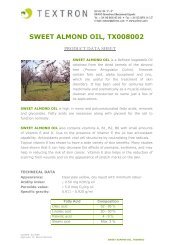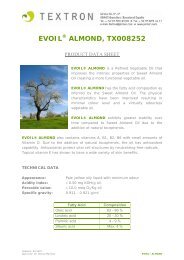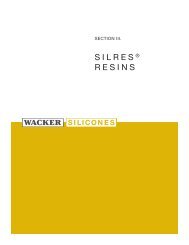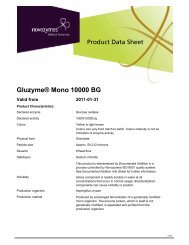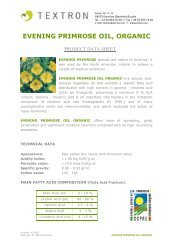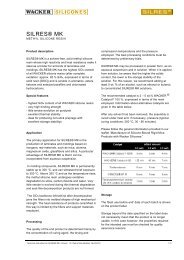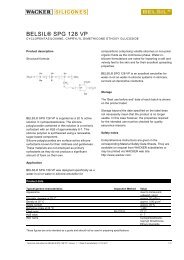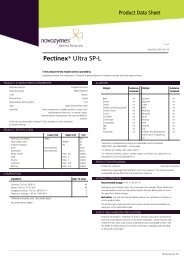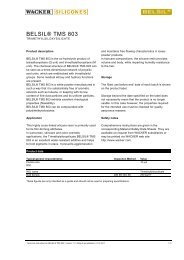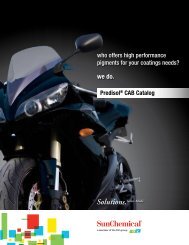Glossary of Terms - Paints and Coatings - Brenntag Specialties, Inc.
Glossary of Terms - Paints and Coatings - Brenntag Specialties, Inc.
Glossary of Terms - Paints and Coatings - Brenntag Specialties, Inc.
You also want an ePaper? Increase the reach of your titles
YUMPU automatically turns print PDFs into web optimized ePapers that Google loves.
CLASSES OF SOLVENTS<br />
Oxygenated Solvents:<br />
General designation <strong>of</strong> those solvents which contain<br />
oxygen in addition to carbon <strong>and</strong> hydrogen in the<br />
molecular. Oxygenated Solvents or “Oxys” may be<br />
divided into several chemical types.<br />
*Ketones - A class <strong>of</strong> active, strong solvents<br />
characterized by a carbonyl group. Trade names<br />
include acetone, methyl ethyl ketone, methyl<br />
isobutyl ketone <strong>and</strong><br />
diacetone alcohol ketones.<br />
*Esters - A class <strong>of</strong> active solvents formed from<br />
organic acids <strong>and</strong> alcohols by the elimination <strong>of</strong><br />
water.<br />
*Alcohols - Latent solvents for many materials.<br />
Characterized by the presence <strong>of</strong> a Hydroxyl (-OH)<br />
group. Capable <strong>of</strong> strong hydrogen bonding. Trade<br />
names include isopropyl alcohol, n-butyl alcohol,<br />
isobutyl alcohol, secondary butyl alcohol, methyl<br />
isobutyl carbinol <strong>and</strong> 2-ethyl hexanol.<br />
*Glycol Ethers - Prepared from alcohols <strong>and</strong><br />
ethylene or propylene oxide. Glycol ethers contain<br />
both ether groups <strong>and</strong> hydroxyl groups, thereby<br />
possessing the characteristics <strong>of</strong> both. Trade<br />
names include butyl ether <strong>of</strong> ethylene glycol <strong>and</strong><br />
the butyl ether <strong>of</strong> diethylene glycol.<br />
Hydrocarbon Solvent Types:<br />
Compounds composed exclusively <strong>of</strong> hydrogen <strong>and</strong><br />
carbon atoms. There are several types <strong>of</strong> hydrocarbon<br />
compounds.<br />
*Olefins - Characterized by unsaturation. Relatively<br />
reactive, used as a raw material for manufacturing<br />
many solvents. Not used in hydrocarbon solvent<br />
directly, although traces <strong>of</strong> olefins may be found in<br />
some hydrocarbon solvents.<br />
*Paraffins - Completely saturated hydrocarbons<br />
characterized by a chain structure. Poorest<br />
solvency <strong>of</strong> the hydrocarbon solvents. Lowest odor.<br />
*Naphthenes - Completely saturated hydrocarbons<br />
characterized by ring structures. Intermediate<br />
solvency between paraffin <strong>and</strong> aromatic<br />
hydrocarbons. Intermediate odor. Also known as<br />
cycloparaffins.<br />
*Aromatics - Characterized by unsaturated, six<br />
carbon benzene ring structures. Hydrocarbon<br />
solvents which contain more that 50% aromatic<br />
compounds are designatd as aromatic hydrocarbon<br />
solvents. Strongest <strong>of</strong><br />
the hydrocarbon solvents. Strongest odor.<br />
Chlorinated Hydrocarbons:<br />
Characterized by the presence <strong>of</strong> chlorine.<br />
Glossaries<br />
8<br />
Nitroparaffins:<br />
Characterized by the presence <strong>of</strong> a nitro group.<br />
SOLVENT STRENGTH<br />
Aniline Cloud Point:<br />
A measure <strong>of</strong> solvent strength, used for aliphatic<br />
hydrocarbon solvents only. The Aniline Cloud Point is<br />
defined as the minimum temperature at which a 1/1 by<br />
volume mixture <strong>of</strong> hydrocarbon <strong>and</strong> pure aniline are<br />
miscible with each other. The Aniline Cloud Point is<br />
also known as Aniline Point <strong>and</strong> Aniline Number. The<br />
st<strong>and</strong>ard test method is ASTM D-611.<br />
Fractional Polarity:<br />
A measure <strong>of</strong> the polar character <strong>of</strong> a solvent. Values<br />
range between zero <strong>and</strong> one, the higher the value, the<br />
more polar the solvent. Hydrocarbons have very low<br />
polarity, while oxygenated solvents have higher<br />
polarity.<br />
Hydrogen Bonding Index:<br />
Measure the strength <strong>of</strong> the hydrogen bonding that<br />
occurs in a solvent. Hydrogen bonding values range<br />
from -18 to +15. Hydrocarbons display little hydrogen<br />
bonding ability, alcohols are strong hydrogen binders,<br />
<strong>and</strong> other solvents are intermediate between these two<br />
extremes. While there are different systems for<br />
measuring hydrogen bonding capability, the Shell<br />
system is based on infrared analysis <strong>of</strong> the solvent.<br />
Kauri-Butanol Value:<br />
A measure <strong>of</strong> solvent strength, used for hydrocarbon<br />
solvents only. A solution <strong>of</strong> Kauri gum in n-butyl<br />
alcohol is titrated to a specified degree <strong>of</strong> turbidity with<br />
the hydrocarbon solvent being tested. Values range<br />
from 20+ to 105. The higher values denote stronger<br />
hydrocarbon solvency. Typical aliphatic hydrocarbons<br />
have KB Values between 28 <strong>and</strong> 40, while aromatic<br />
hydrocarbons have KB Values above 70. The<br />
st<strong>and</strong>ard test method is ASTM Method D-1133<br />
Mixed Aniline Cloud Point:<br />
A measure for solvent strength, used for aromatic<br />
hydrocarbon solvents only. The same equipment is<br />
used as for the Aniline Cloud Point employed for<br />
aliphatic hydrocarbon solvents, except that the<br />
aromatic hydrocarbon solvent is diluted with an equal<br />
volume <strong>of</strong> pure n-heptane before mixing with aniline.<br />
The st<strong>and</strong>ard test method is ASTM D-611.<br />
Solubility Parameter:<br />
A measure <strong>of</strong> solvency whose major usefulness lies in<br />
predicting whether a particular solvent will dissolve a<br />
particular resin. Based on heat <strong>of</strong> vaporization <strong>of</strong> the<br />
MINERALS COLORS CHEMICALS ADDITIVES RESINS EQUIPMENT






